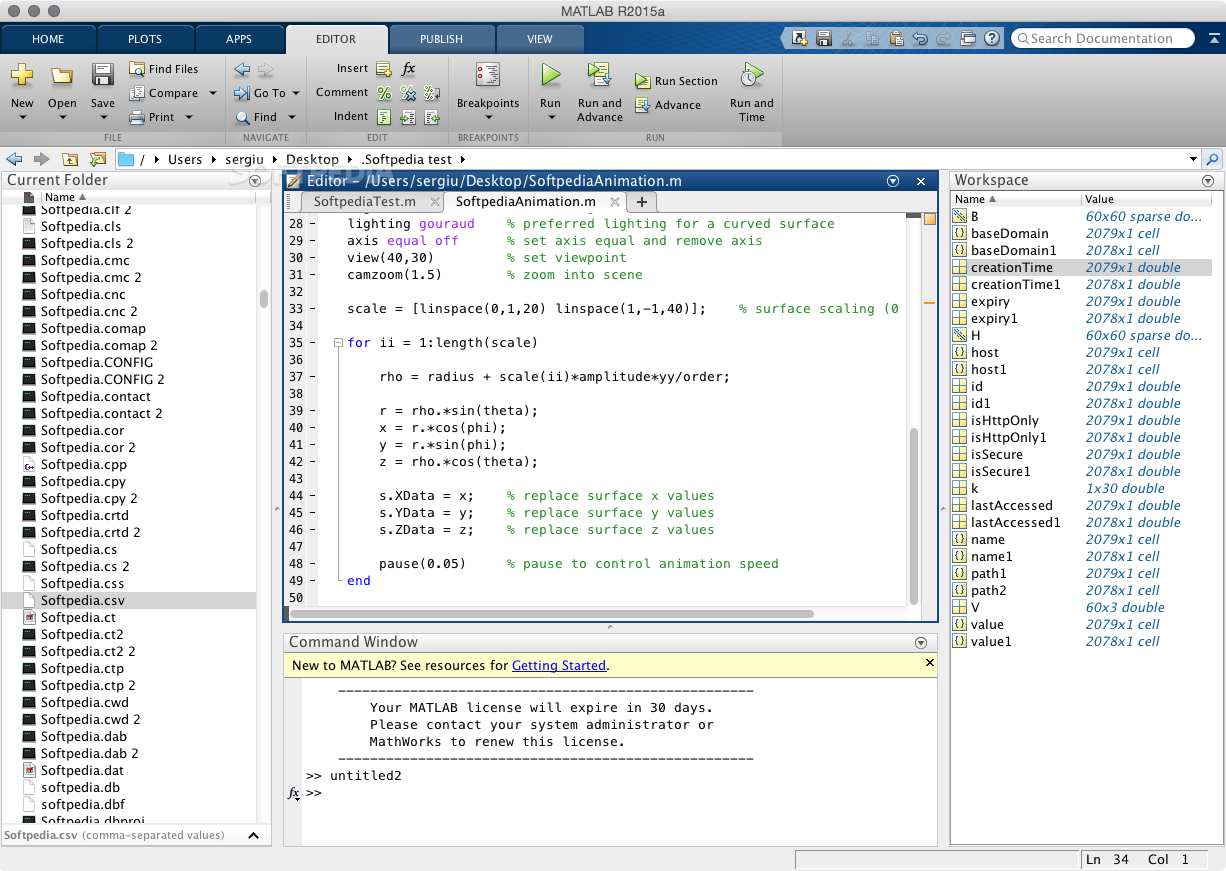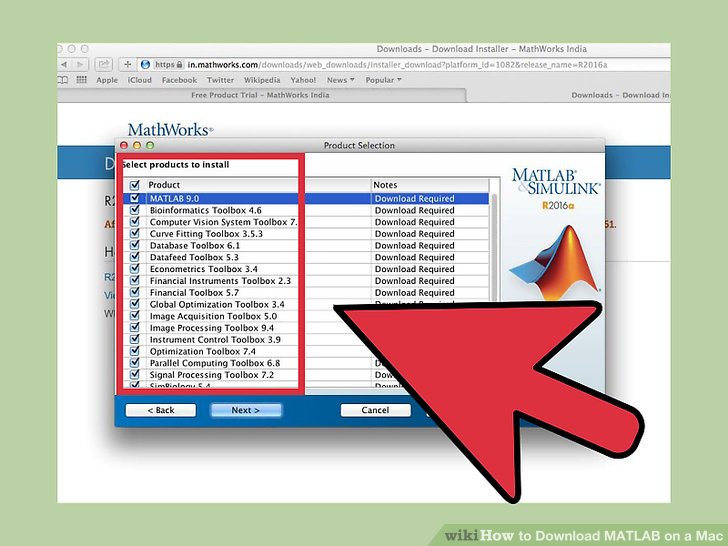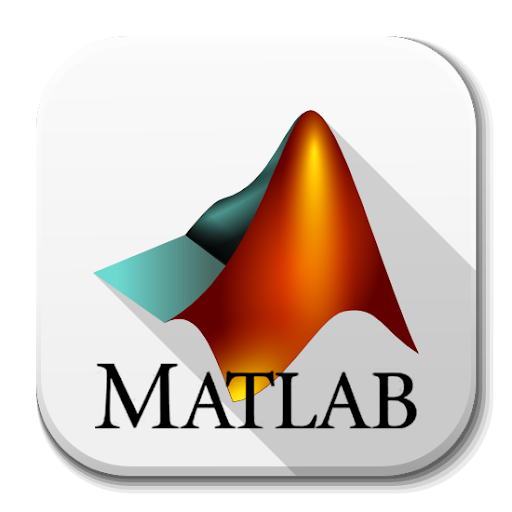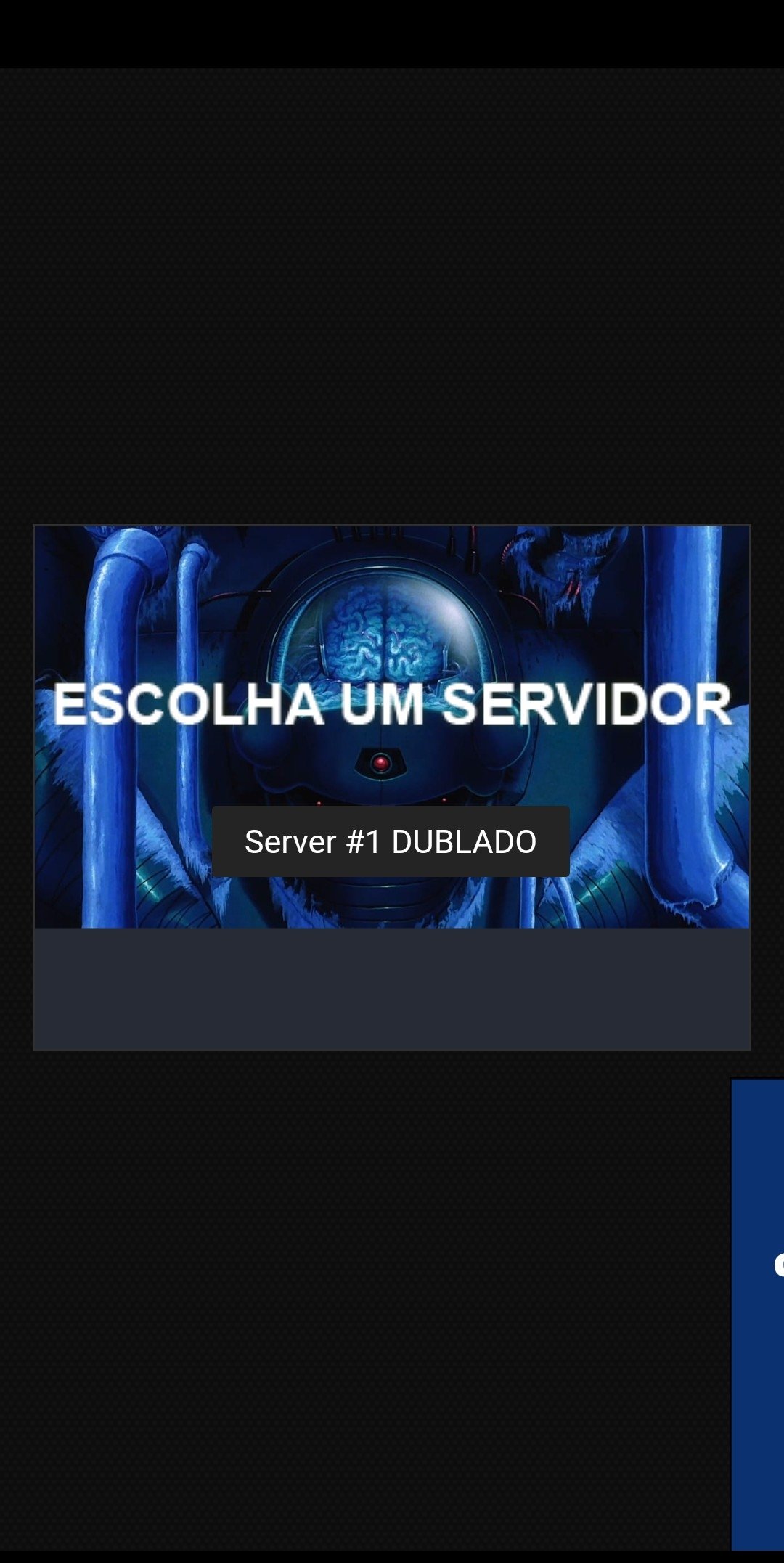8/10 (68 votes) - Download MATLAB Mac Free. MATLAB is one of the most powerful mathematical calculation tools available. Download MATLAB and get hold of this software to work with maths calculations. MATLAB is the most complete, stable and reliable program in the world for the development of. MATLAB Software for Mac downloads free Author Downloads, MATLAB Software Download Link: Download link for mac OS 2019 For other versions: MATLAB Software download. MATLAB 2021 Crack for MacOS Download Google Drive & Mega Links Download MATLAB 2021 for MAC OS - Link to download Google drive MATLAB 2021 for Mac is the giant software in mathematical computation, it is widely used in almost all fields of computation. Download MATLAB R2018a for Mac Free. It is full Latest Version setup of MATLAB R2018a Premium Pro DMG for Apple Macbook OS X. Brief Overview of MATLAB R2018a for Mac OS X. MATLAB R2018a for Mac is a very handy application which can be used for mathematical computation and visualization. So, you’ve decided to download an older version of Mac OS X.
Thanks to Robert Coghill for sponsoring the Apple port.
Contents:
- FSL install script
Prerequisites
Before you install FSL you should first ensure that you have the X11 windowing system installed. To do this, look for the X11 application in the Utilities folder within the Applications folder (switch to the Finder and hit Apple-Shift-U to open the Utilities folder); by default versions of Mac OS X prior to 10.5 doesn't normally come with this installed (you'll almost certainly need X11 later for things other than FSL anyway).
If you do not have X11 then install it from the OS X Install CD. Insert the CD, open it in the Finder, scroll down to the Optional Installs.mpkg package and double click to launch the installer (in Mac OS X 10.5, the package is in the Optional Installs folder). Click through until the custom install window appears, expose the Applications section and select X11. Now click on 'Install'
FSL Install Script
An automated installer, fsl_installer.sh is available to carry out the installation (or application of a patch). In addition it will install FSLView into /Applications, automatically configure your environment to enable you to run FSL and (on Mac OS X 10.4) will configure the Apple Terminal application to allow the launching of X11 applications from it. Finally, if you use Matlab it will configure your startup.m file to allow you to use the FSL Matlab functions.
- fsl_installer.sh - Version 1.6 09/02/2012
Running the installer
Once you have downloaded the installer, open a Terminal (look in the Utilities folder in Applications), change to the folder containing the downloaded file (for example if you downloaded to your Desktop):
(On Mac OS X 10.5, Safari defaults to downloading files into ~/Downloads)

and run it with:
Assuming that this folder also contains the FSL distribution tar file and you wish to install into /usr/local then just press Return when the installer asks a question, to accept the defaults. Be aware that you may need Administrator priviledges to install into certain folders on your computer - /usr/local being an example, the installer will ask for your password if necessary to allow this.
For more information on controlling the installer, run it with the -h option.
Configuring your account for FSL usage using the install script
In addition to installing the FSL programs, the install script is also capable of configuring your user account to enable you to run the FSL programs. If your user account was used to run the installer when installing the FSL programs, this will have already been done, but you may also want to configure additional accounts. To do this, log in as the user wishing to run FSL and execute the installer with the -e option, eg:
Checking the installation
Test that the environment and command line tools are set up correctly by doing the following:
- Quit the Terminal program and start it again
- Check that your environment is correct by typing: This should display the name of the directory that you installed FSL in.
- Check that your path is correct by typing: which should display a line like: (although the version number might be different).
In general, to run the FSL tools from the command line (within a terminal) you need to enter the program name in lower case (e.g. bet). Typing a command on its own (without any arguments or options) gives you a help message for that command.
A more complete test of the FSL installation can be run at this pointby using the testing and evaluation suite FEEDS.
Running the GUIs
Mac OS X 10.4
Once you have checked the environment and command line programs, as described above, then start X11 (click on it in the Utilities folder inside the Applications folder). All of the FSL GUIs should now work. To run a GUI version of a program you can either type its capitalised name with an additional '_gui' appended in the terminal (e.g. Bet_gui), or you can start the main FSL GUI by just typing fsl.
Mac OS X 10.5
There is no need to launch X11.app before starting any of the FSL GUIs, the X11 system automatically launches. To run a GUI version of a program you can either type its capitalised name with an additional '_gui' appended in the terminal (e.g. Bet_gui), or you can start the main FSL GUI by just typing fsl.
If you have upgraded from 10.4, then you may have a .bash_profile (or .tcshrc or .cshrc) that breaks this behaviour. If you installed using the fsl_installer.sh script then download the current version, fsl_installer.sh, and re-run using the -e option from a terminal:
assuming that your web browser downloads to the folder ~/Downloads.If you have manually added this to your shell setup file then look for a line that changes/sets the DISPLAY environment variable and remove it. New shells will then behave as expected.
Also note that at this time, Apple's X11.app as shipped, has a large number of bugs and performance issues. Until such time as an offical release corrects these problems, you may see significant improvements by installing the testing release available at http://www.x.org/wiki/XDarwin (follow the instructions for a Binary installation).
Using Matlab libraries
FSL ships with several Matlab scripts for loading Analyze files. These libraries are dependant on FSL environment variables which aren't set in the Mac OS X Desktop environment, so won't run in a Matlab session started from the /Applications/MATLAB.app launcher. There are two options:
- Run Matlab from a correctly configured Terminal (assuming Matlab 7.4 - adjust as appropriate for your version) or
- Configure the FSL environment variable in your ~/matlab/startup.m file (create it if it doesn't already exist) - add the following (assuming FSL installed in /usr/local):
Further help
If any problems occur when installing or running the FSL tools, please consult the FSL FAQ. This also contains instructions on how to join and use the FSL email list to ask specific questions which are not covered in the FAQ.
Manual Installation
- Verify the download
- Visit our checksums page to download the MD5 sum file that matches the
.tar.gz package you have downloaded. Make sure that the.md5 file is in the same directory as the downloaded FSL distribution file. - Open up a Terminal (you can find this application in Utilities folder inside the Applications folder).
- In the terminal, change to the directory where you downloaded the FSL distribution, e.g.
- Check the file with NB ` is on the key to the left of Z on the UK Mac keyboard, or to the left of 1 on the US Mac keyboard
- If there is a problem with the download then you will receive a message like:
- Visit our checksums page to download the MD5 sum file that matches the
- Unpack the FSL distribution
- Open up a Terminal (you can find this application in Utilities folder inside the Applications folder).
- In the terminal, change to the directory where you want FSL installed, e.g.
- Unpack the fsl download file - for example, if you downloaded it onto your Downloads folder, (omit the z in the -zxvf if your computer has already uncompressed the tarfile for you). This will create a directory called fsl in the current directory which will contain all the required files for FSL and FSLView. Note that you might need to add sudo to the start of the tar command if you don't automatically have the right to create files in /usr/local.
- Install the applications
- To get a clickable application icon FSLView, open a file browser in the top-level fsl directory, e.g. and drag the fslview.app directory into your Applications folder or your Desktop.
- Find out which shell you are running. In a terminal, type: the output will be either a list of commands, in which case you are using the bash shell, or an error saying 'command not found' or similar message, in which case you are using the tcsh or csh shell.
- Set up your user environment.
If you are using the bash shell (the default)
- In a running terminal type: This will bring up a TextEdit window
- Select Make Plain Text from the Format menu if it is available (if only Make Rich Text is there then do nothing as it is already in plain text mode)
- In the window type the following lines at the end of the document (or better still, use copy and paste to do this):
Note that the second line starts with a dot (i.e. full stop or period), then a space, then ${FSLDIR}/etc/fslconf/fsl.sh - the dot and space are very important!
For Mac OS X 10.4 and earlier (NOT Mac OS X 10.5), also include the following:
- Change the line FSLDIR=/usr/local/fsl and replace /usr/local/fsl with the directory name of the place where you installed FSL.
- Save the file and exit TextEdit
If you are using the tcsh or the csh shell
- In a running terminal type: This will bring up a TextEdit window
- Select Make Plain Text from the Format menu if it is available (if only Make Rich Text is there then do nothing as it is already in plain text mode)
- In the window copy and paste the following in at the end of the document:
For Mac OS X 10.4 and earlier (NOT Mac OS X 10.5), also include the following:
- Change the line setenv FSLDIR /usr/local/fsl and replace /usr/local/fsl with the directory name of the place where you installed FSL.
Among other things, R2008b makes Matlab an OS X package, so it looks like a 'real' OS X application. 'Value' (rating) is hard for me to judge because my university has a site license. While there are things to complain about, I for one am very pleased to have it on the Mac, and working quite well (albeit a little clunkily) for my needs. MAC OS X Tiger 10.4 ISO DMG File for Free. The next line up from Mac OS X is on hold and apple is definitely taking it slow in making sure that the output of the systems much more efficient and improve the quality in terms of screen output and refinement. The Mac OS X Tiger is by far the best OS that made the mark in the line up of OS X.
- Do you having trouble downloading MATLAB to your Mac? MATLAB is a programming software that most undergraduate engineering students will download and use during their college career. This article will explain step-by-step how to download MATLAB.
- The Mac OS X Mountain Lion 10.8 ISO stands thirteenth in the Mac OS arrangement. Mac OS X Mountain Lion 10.8 ISO propelled in mid-2016 made an uncommon passage into the market after the OS X. Mac OS X Mountain Lion 10.8 ISO made a progressive move from the ongoing patterns in the Mac OS history.
- Download MATLAB R2018a for Mac Free. It is full Latest Version setup of MATLAB R2018a Premium Pro DMG for Apple Macbook OS X. Brief Overview of MATLAB R2018a for Mac OS X. MATLAB R2018a for Mac is a very handy application which can be used for mathematical computation and visualization.
So, you’ve decided to download an older version of Mac OS X. There are many reasons that could point you to this radical decision. To begin with, some of your apps may not be working properly (or simply crash) on newer operating systems. Also, you may have noticed your Mac’s performance went down right after the last update. Finally, if you want to run a parallel copy of Mac OS X on a virtual machine, you too will need a working installation file of an older Mac OS X. Further down we’ll explain where to get one and what problems you may face down the road.
A list of all Mac OS X versions
We’ll be repeatedly referring to these Apple OS versions below, so it’s good to know the basic macOS timeline.
| Cheetah 10.0 | Puma 10.1 | Jaguar 10.2 |
| Panther 10.3 | Tiger 10.4 | Leopard 10.5 |
| Snow Leopard 10.6 | Lion 10.7 | Mountain Lion 10.8 |
| Mavericks 10.9 | Yosemite 10.10 | El Capitan 10.11 |
| Sierra 10.12 | High Sierra 10.13 | Mojave 10.14 |
| Catalina 10.15 |
STEP 1. Prepare your Mac for installation
Given your Mac isn’t new and is filled with data, you will probably need enough free space on your Mac. This includes not just space for the OS itself but also space for other applications and your user data. One more argument is that the free space on your disk translates into virtual memory so your apps have “fuel” to operate on. The chart below tells you how much free space is needed.
Note, that it is recommended that you install OS on a clean drive. Next, you will need enough disk space available, for example, to create Recovery Partition. Here are some ideas to free up space on your drive:
- Uninstall large unused apps
- Empty Trash Bin and Downloads
- Locate the biggest files on your computer:
Go to Finder > All My Files > Arrange by size
Then you can move your space hoggers onto an external drive or a cloud storage.
If you aren’t comfortable with cleaning the Mac manually, there are some nice automatic “room cleaners”. Our favorite is CleanMyMac as it’s most simple to use of all. It deletes system junk, old broken apps, and the rest of hidden junk on your drive.
Download CleanMyMac for OS 10.4 - 10.8 (free version)
Download CleanMyMac for OS 10.9 (free version)

Download CleanMyMac for OS 10.10 - 10.14 (free version)

STEP 2. Get a copy of Mac OS X download
Normally, it is assumed that updating OS is a one-way road. That’s why going back to a past Apple OS version is problematic. The main challenge is to download the OS installation file itself, because your Mac may already be running a newer version. If you succeed in downloading the OS installation, your next step is to create a bootable USB or DVD and then reinstall the OS on your computer.
How to download older Mac OS X versions via the App Store
If you once had purchased an old version of Mac OS X from the App Store, open it and go to the Purchased tab. There you’ll find all the installers you can download. However, it doesn’t always work that way. The purchased section lists only those operating systems that you had downloaded in the past. But here is the path to check it:
- Click the App Store icon.
- Click Purchases in the top menu.
- Scroll down to find the preferred OS X version.
- Click Download.
This method allows you to download Mavericks and Yosemite by logging with your Apple ID — only if you previously downloaded them from the Mac App Store.
Without App Store: Download Mac OS version as Apple Developer
If you are signed with an Apple Developer account, you can get access to products that are no longer listed on the App Store. If you desperately need a lower OS X version build, consider creating a new Developer account among other options. The membership cost is $99/year and provides a bunch of perks unavailable to ordinary users.
Nevertheless, keep in mind that if you visit developer.apple.com/downloads, you can only find 10.3-10.6 OS X operating systems there. Newer versions are not available because starting Mac OS X Snow Leopard 10.7, the App Store has become the only source of updating Apple OS versions.
Matlab Free Download For Pc
Purchase an older version of Mac operating system
You can purchase a boxed or email version of past Mac OS X directly from Apple. Both will cost you around $20. For the reason of being rather antiquated, Snow Leopard and earlier Apple versions can only be installed from DVD.
Buy a boxed edition of Snow Leopard 10.6
Get an email copy of Lion 10.7
Get an email copy of Mountain Lion 10.8
The email edition comes with a special download code you can use for the Mac App Store. Note, that to install the Lion or Mountain Lion, your Mac needs to be running Snow Leopard so you can install the newer OS on top of it.
How to get macOS El Capitan download
If you are wondering if you can run El Capitan on an older Mac, rejoice as it’s possible too. But before your Mac can run El Capitan it has to be updated to OS X 10.6.8. So, here are main steps you should take:
1. Install Snow Leopard from install DVD.
2. Update to 10.6.8 using Software Update.
3. Download El Capitan here.
“I can’t download an old version of Mac OS X”
If you have a newer Mac, there is no physical option to install Mac OS versions older than your current Mac model. For instance, if your MacBook was released in 2014, don’t expect it to run any OS released prior of that time, because older Apple OS versions simply do not include hardware drivers for your Mac.
But as it often happens, workarounds are possible. There is still a chance to download the installation file if you have an access to a Mac (or virtual machine) running that operating system. For example, to get an installer for Lion, you may ask a friend who has Lion-operated Mac or, once again, set up a virtual machine running Lion. Then you will need to prepare an external drive to download the installation file using OS X Utilities.
After you’ve completed the download, the installer should launch automatically, but you can click Cancel and copy the file you need. Below is the detailed instruction how to do it.
STEP 3. Install older OS X onto an external drive

The following method allows you to download Mac OS X Lion, Mountain Lion, and Mavericks.

- Start your Mac holding down Command + R.
- Prepare a clean external drive (at least 10 GB of storage).
- Within OS X Utilities, choose Reinstall OS X.
- Select external drive as a source.
- Enter your Apple ID.
Now the OS should start downloading automatically onto the external drive. After the download is complete, your Mac will prompt you to do a restart, but at this point, you should completely shut it down. Now that the installation file is “captured” onto your external drive, you can reinstall the OS, this time running the file on your Mac.
- Boot your Mac from your standard drive.
- Connect the external drive.
- Go to external drive > OS X Install Data.
Locate InstallESD.dmg disk image file — this is the file you need to reinstall Lion OS X. The same steps are valid for Mountain Lion and Mavericks.
How To Download Matlab For Mac Download
How to downgrade a Mac running later macOS versions
If your Mac runs macOS Sierra 10.12 or macOS High Sierra 10.13, it is possible to revert it to the previous system if you are not satisfied with the experience. You can do it either with Time Machine or by creating a bootable USB or external drive.
Instruction to downgrade from macOS Sierra
Instruction to downgrade from macOS High Sierra
Instruction to downgrade from macOS Mojave
Instruction to downgrade from macOS Catalina
Before you do it, the best advice is to back your Mac up so your most important files stay intact. In addition to that, it makes sense to clean up your Mac from old system junk files and application leftovers. The easiest way to do it is to run CleanMyMac X on your machine (download it for free here).
Visit your local Apple Store to download older OS X version
If none of the options to get older OS X worked, pay a visit to nearest local Apple Store. They should have image installations going back to OS Leopard and earlier. You can also ask their assistance to create a bootable USB drive with the installation file. So here you are. We hope this article has helped you to download an old version of Mac OS X. Below are a few more links you may find interesting.